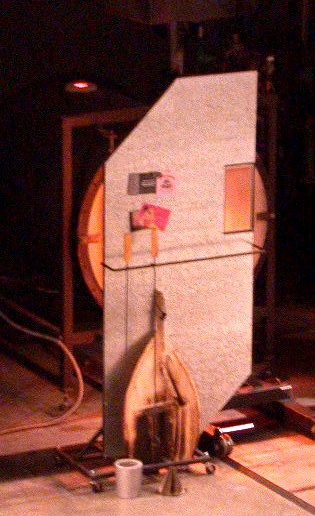|
Before the glassblowing session begins, the pot
furnace or tank furnace must be brought up
to temperature (about 2050-2100°F) from the setting it held overnight (about 1800F to
save fuel.)
(The process
of melting batch or cullet to
get workable glass is discussed here)
The glory hole for reheating
must be brought up to temperature (~2200-2300F) as well as the controlled
cooling annealers
(~900F), preheating color oven, pipe heater,
and garage. Depending on equipment design,
these steps take about an hour. During this time, the artist is
normally setting up the preheating of color bar and laying out
stringer, frit,
and powder (linked below as
discussed), arranging tools, and pulling the previous day's or
afternoon's work from the annealers. Pipes and punties are
arranged in the pipe warmer for use during the
session. Water is put in holding buckets and crack off bins/buckets
, if used. If hand torches are used,
they will be lighted or set out.
Most furnace glassworkers use a team approach for making glass with at least
one assistant who may be a partner alternating on the bench or a less
experienced glass blower who gets some blowing time during the day. A
minority of furnace workers work alone (as I do) and some pieces are more
difficult and some impossible when alone and different techniques are used to
compensate. Large pieces and production shops often involve teams of 3, 4,
5 or more working together. These additional people may take the partially
worked piece back for reheating, giving the gaffer a break; may make added bits
like handles; may bring color bits to a nearly molten state for application; may
prepare and hold the punty as mentioned below; and may suit up to carry the
finished but still hot piece to the annealer. [2010-12-22 add.]
The creation of an object commonly begins by making or taking out a drawing
so that all involved know the piece to be made and the steps involved. In a
production situation there may be metal templates or calipers to gauge heights,
diameters and shapes. Building the object begins by taking the pipe from the pipe heater
where it has been pre-heating. A pipe that is cold will simply push a hole in
the molten glass instead of gathering or the glass will chill around the small
hole, preventing blowing from happening. Upon opening the
door to the furnace, the pipe is tipped at an
angle into the pool of glass and moved across while turning the pipe and pulling
a gather of glass. If left in too long, the pipe get so hot the glass flows off.
Pulling the pipe, the door must be closed and the pipe turned to maintain an
even shape of glass. The glass worker most commonly goes to a
marver to roll the gather into a blunt cone against
the flat surface. Using breath, a small bubble is started in the
center of the glass and enlarged to the size the worker desires.
(The primary glassworker is called a gaffer from an old word for
grandfather, but I am not using the term here because when a team
is working glass, any of the workers, not just the gaffer, may
marver and otherwise work the glass.) If the pipe end is too cold, the
glass will stiffen immediately and the bubble won't start. If it is too
hot, only a thin shell of glass will be picked up, wasting time. The exact
temperature of the glass in the furnace will depend on the preferences of the
gaffer and the need to gather glass in thin or thick layers as higher
temperature glass is thinner. [rev 2009-08-23]
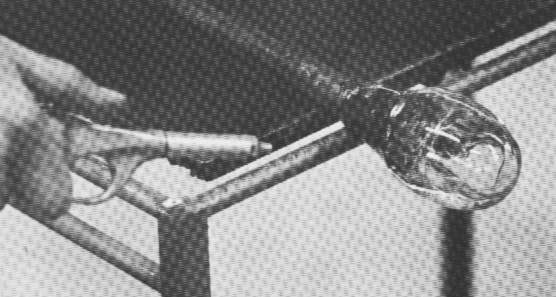 When the glob glass, called a
parison, is shaped,
it is allowed to cool further. This both assures that the shape
will not collapse when more molten glass is gathered around it and
increases the amount of glass that can be picked up in the second
gather. A pipe usually has a small hole in the end with a thick rim around
it. It is possible to blow glass with an open pipe (straight wall thickness) but
it does not support the piece well. When the glob glass, called a
parison, is shaped,
it is allowed to cool further. This both assures that the shape
will not collapse when more molten glass is gathered around it and
increases the amount of glass that can be picked up in the second
gather. A pipe usually has a small hole in the end with a thick rim around
it. It is possible to blow glass with an open pipe (straight wall thickness) but
it does not support the piece well.
Many pieces start with an additional step. The worker heats
the end of the pipe, but rather than gathering the glass, a chunk
of color is picked up as a short cylinder preheated in a color kiln. The old skin of glass on the pipe is usually
enough to stick the pickup. The color is softened in the glory
hole and marvered to shape as described above. As other glass is
gathered over it, the color forms the inner lining of the piece
and colors the whole piece. When desired, two or more chunks of
glass may be worked this way to form layers. If the color chunk
contains lead or other heavy metals and the object will hold food
or drink, the color may be picked up after the first gather and smoothed over it so the
inside of the piece is a thin layer of clear with color over it
and more clear (later gathers) over that. Some studios melt
colored glass which may be used for the first gather or for
adding details later but most studios melt a large pot/tank of
clear and use solid color.
After the second gather, the worker normally has enough glass
that a change of techniques is required, although returning to
the marver to shape the second and third gather or even the whole piece
is used by some workers. Most workers will go to the bench and use wooden blocks or a pad of newspaper
to block or shape the glass. A team member may blow while the gaffer turns to
shape the glass against the block; a solo worker may use an extension air tube. If further gathers are to be made,
the object of blocking is to control the shape of the piece
including the thickness of the glass. Again the piece will be
worked and cooled to stiffen the shape to permit more glass to be
gathered. During gathering, steps may be taken that are part of
the design, where the design calls for color within the glass.
This may include threading,
picking up cane, or adding bubbles. The bubble inside the glass
may be enlarged during the gathering. The glass may be
selectively chilled (on the sides or the bottom) to cause more
glass to be gathered there or to encourage the bubble to move
into the hotter area. Following gathering, the worker may drain excess glass just gathered into
a water filled bucket to form a thinner smoother layer around the
piece.
At some point enough glass has been gathered to make the piece.
The next step is normally to use bladed jacks
to narrow a neck on the piece near the end of the pipe. This is
the line where the piece will separate from the pipe. The piece
is taken back to the glory hole for reheating.
The glory hole is usually maintained at a temperature higher than
the furnace, so it reheats the glass quickly. The heat transfers
from the walls and air of the glory hole, heating it all around,
supplying more heat per second than a torch would. Because the
glass near the pipe is behind the rest of the piece (in the
shadow of the heat) it may take several reheats to jack the line
properly, so other work may be done as the jacking proceeds. The gaffer must
work to keep the glass centered in line with the pipe.
During this stage, the worker may use other jacks, other
blocks, the newspaper, the paddles, and the
marver to form the piece. A co-worker may kneel at the end of the
pipe on the bench and blow in the pipe as it rolls (a fun task),
blowing while the gaffer applies shaping pressure with the paper,
etc. (A gaffer, especially working alone, may also use an air hose over the pipe mouth piece to apply air
pressure while the pipe is on the bench, using breath or low
pressure compressed air.) Air or pads may also be used to
selectively cool the glass so that when it is reheated, other parts will begin
at a higher temperature and get even warmer and softer than the chill parts.
Gravity and centrifugal force may be used. If the pipe is
pointed down while turning, the piece will tend to lengthen;
while pointing it up will shorten. Some caution is required when pointing
up as hot bits of metal corrosion may be in the pipe which must be cleaned out. If the pipe is swung back and
forth or (spectacularly in demonstrations) swung completely
overhead the piece will stretch and thin, doing more so near the
neck (because more glass is pulling from further out) or where
the glass is hottest.
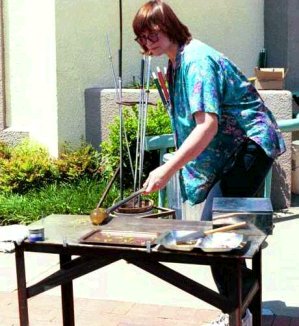 The
worker is mostly working on the lower half of the piece. Steps
the worker might take include using an optic or
other mold to impress a pattern or shape on
the glass and using various techniques to add color including threading and rolling the piece in frit or powder
which may be in a scoop shape or laid out on the marver. The
worker is mostly working on the lower half of the piece. Steps
the worker might take include using an optic or
other mold to impress a pattern or shape on
the glass and using various techniques to add color including threading and rolling the piece in frit or powder
which may be in a scoop shape or laid out on the marver.
The last step before taking the piece off the pipe is
finishing the bottom where the punty will be attached. Normally
this involves flattening the bottom and adding any foot or feet
desired. It may also involve adding a pad of glass (cookie) to keep the bottom from
breaking out when the piece is puntied.
If glass is being produced as quickly as possible and a
polished rim is not important, all the following steps are
ignored and the piece is cracked free and taken to the annealer
immediately. The top of the cooled piece is sawn square and ground to
final shape. Low cost vases and garden decorations with added
caps may have this shortcut used as well as pieces blown into metal forms.
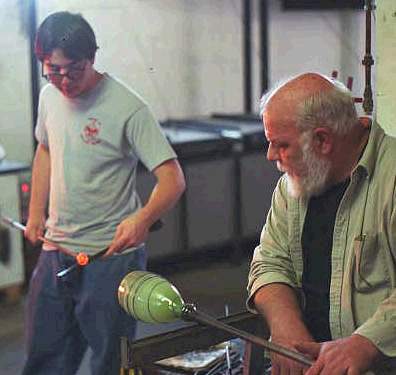 The
most critical step in working the glass is getting the piece off
the pipe and onto the punty. The problems are
rooted in the desire later on to remove the punty with little
scarring and as little cold working as
possible. The artist or assistant gathers a small amount of glass
on the punty and quickly marvers it to shape, usually a blunt
cone. The glass is then usually touched to some surface to chill
it and pattern its surface. The goal is to make a good enough but
not TOO good connection to the glass. If the connection is not
good enough the piece will fall off the punty. The first and
perhaps most likely time for this to occur is when the pipe is
rapped to crack it free. If the connection is too good, it may crack the bottom
of the piece at the end of the session. In production situations, it is
common to have a mechanical punty (a gimmick or
sabot) that encloses or grips the piece to avoid the risks
and time of the hot punty process.) The
most critical step in working the glass is getting the piece off
the pipe and onto the punty. The problems are
rooted in the desire later on to remove the punty with little
scarring and as little cold working as
possible. The artist or assistant gathers a small amount of glass
on the punty and quickly marvers it to shape, usually a blunt
cone. The glass is then usually touched to some surface to chill
it and pattern its surface. The goal is to make a good enough but
not TOO good connection to the glass. If the connection is not
good enough the piece will fall off the punty. The first and
perhaps most likely time for this to occur is when the pipe is
rapped to crack it free. If the connection is too good, it may crack the bottom
of the piece at the end of the session. In production situations, it is
common to have a mechanical punty (a gimmick or
sabot) that encloses or grips the piece to avoid the risks
and time of the hot punty process.)
If the worker has successfully jacked the piece and properly
tempered and attached the punty, when the pipe is rapped with a
hard tool, the piece parts cleanly and without much shock. Many glass workers
put water on the joint with tweezers to cool and shock it. If the
punty glass is too hot, there may be a bit of frantic turning and
twisting of the punty to keep the piece centered and in place.
Most commonly, the gaffer places the punty tip with shears while
an assistant holds the punty level. The gaffer then raps the pipe
when everything seems right and the assistant catches weight of
the piece and goes immediately to the glory hole. (If the piece
has not been properly puntied, or the neck not properly narrowed
or chilled, rapping on the pipe may result in both ends of the
piece breaking free, resulting in a "floor model" - a
broken piece.)
Commonly, in a small studio, the gaffer follows the assistant
and takes the punty while handing the pipe to the assistant who
puts it in the crack off bin while the gaffer turns the piece in
the glory hole. In a larger operation, a team member other than
the gaffer will reheat. Notice that the end of the piece going in
the glory hole has been determinedly chilled for the past several
minutes so it will crack free and now it must be heated up to
soft working temperature while keeping the rest of the piece
tepid or at least firm.. It is possible that the end has gotten
so cold that it cracks in error, so it should be eased into the
glory hole.
When the piece is pulled from the glory hole, it is time to
work on the rim and upper body of the piece. If the piece has
been necked severely, the inner hole may be too small and it must
be worked open with pick or tweezers.
In more ordinary work, the jacks are used with the blades
parallel to form a broader working surface to turn the rim open.
Many glass workers next pick up duckbill shears to
trim away excess glass and shape the lip. Trimming is normally
done with very soft glass and at the bottom as the piece is
turned horizontally, so the scrap falls toward the floor and does not mar the
piece. On goblets and thin pieces, the goal may be to remove the
thicker or uneven glass at the jack point. On a pitcher, the goal
may be to provide the profile that will yield a projecting lip.
The cut glass normally falls on a metal tray provided for the
purpose.
Frequently these days, a lip wrap of
contrasting color is added. Continuing work shapes the top of the
piece, perhaps the size being gauged to match a lid previously
made or to allow for a stopper. With an assistant or alone,
additional bits are added for decoration and for handles. During
this time, the worker will return the piece to the glory hole to
keep it from cracking.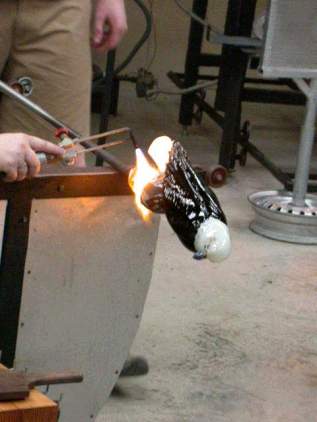 A torch may be used to
apply heat to the bottom of the piece and/or the punty glass when
trying to heat this area in the glory hole would soften the rest
of the piece too much. A torch may also be used to heat a spot
where a bit or garaged section is to be attached. A torch may be used to
apply heat to the bottom of the piece and/or the punty glass when
trying to heat this area in the glory hole would soften the rest
of the piece too much. A torch may also be used to heat a spot
where a bit or garaged section is to be attached.
When the piece is complete, the next critical step is to
remove it from the punty, which requires that the punty glass be
removed without taking a chunk out the bottom of the piece. If
the punty was applied properly, removing the piece is merely a
matter of chilling the join, usually with a thin knife edge. If
the worker has any doubts about the separation, a number of
tricks/techniques exist to encourage the break to occur in the
punty glass and not in the piece. They must be applied quickly as
the glass is cooling rapidly and unevenly.
The piece is normally removed with a sharp rap to the punty.
What happens to the piece depends on the worker and the piece.
Some pieces can be placed in the annealer by holding the punty
vertically, lowering the piece to a fraction of an inch above the
annealer floor, and rapping. Gloves are
available which will withstand the 800-1000°F heat for a short
time. The worker may hold the piece over a padded drop table and
crack off onto that and then use gloves to move the piece into
the annealer while positioning it as desired. With an assistant,
the gloves can be used to catch the piece (usually above the
crack off table for insurance) at the rap and carry it to the
annealer. With large pieces of glass, the assistant will be
garbed in full silver fire fighting reflective gear. Handling the
piece permits the option of setting it on its bottom or side.
With the piece in the annealer, it is likely that members of
the team and any audience will applaud the success, especially if
it is a large, tricky piece. Water, etc., is drunk, a snack eaten. The various tools and pipes are
arranged for working the next piece and it begins again. The
piece will soak in the annealer for an hour or more (often to the
end of the day) and then will be annealed (cooled
slowly) so the glass is as free of stress as possible. For
ordinary art glass pieces, the temperature is reduced from about 900°F
to about 600°F over 6-8 hours in a controlled way and then
allowed to cool to near room temperature over 3-4 hours or more. Thicker
pieces including castings may require days for proper cooling.
Depending on the time taken for the piece, the production nature of the shop,
etc., the people involved may take a break, drink fluids, etc., before
continuing the piece. In a factory, the team works for a couple of hours,
making a piece every few minutes, before breaking, some people sitting all the
time, others carrying the glass. In a production studio, the gaffer may
work at the glory hole or remain seated.
At the end of the session, the glory hole is turned off, the furnace turned
down or recharged, the annealer is set to begin the cooling process, water is
thrown out, tools picked up or lined up, the floor swept, and trash thrown out,
ready for the next session.
Kile Glassworks Renaissance style
|
|
- A
- Air, Natural Air
- Most glass workers use air from the mouth to gently form glass on the
pipe and after. A common sight is an assistant kneeling by the bench moving
with the end of the pipe mouthpiece blowing while the gaffer shapes the
piece. Solo workers use a blowpipe hose extension,
where surgical tubing (a very soft light amber color) is used with an elbow
swivel that allows the pipe to rotate when the hose is attached. Besides the
hose, an adaptor is needed to fit over the pipe mouth piece. I made mine
from short pieces of clear soft vinyl tubing, which I forced inside each
other to change from the small tubing on the swivel to the large diameter of
the pipe. The puffer is often natural air. 2004-07-26

- Air, Compressed
- Since high pressure (120 psi) air is useful for running tools and sand
blasting, many studios have compressed air at the bench where it is usually
very low pressure (5 psi or less). The two most common uses are
cooling selectively and with the puffer. Many shops have doors operated by
compressed air cylinders. Created with a central or local
air compressor. 2004-07-26
- Air Gun or Nozzle
- A tool with a trigger for releasing moderate to large amounts of air
which is placed on a compressed air hose convenient for cooling glass
selectively. (right) 2005-08-21
- Air Compressor and Air Hose
- A motor driven device using pistons, diaphragms, or rotary vane pumps to
increase the pressure of atmospheric air so that it can be stored and
distributed to do work or provide a blast of air. Usually electric in
shops. Commonly the pump unit is mounted on the storage tank which may
be on wheels or a larger upright cylinder. Small compressors without
tanks are available, usually for painting. Distribution can be by
reinforced rubber hoses or metal piping. PVC pipe is strongly
discouraged for this use as it breaks with time and fires across the shop.
Many shops have quick connect fittings located above head height at each
work station.
Air driven, or pneumatic, tools are widely available for automobile work and
include low and high speed grinding, hammer scaling and cutting bits, socket
drivers, etc. The tools are much lighter than electric (no metal
windings inside.) Some use a lot of air and require bigger compressors
and tanks than many shops have. Tools are high pressure devices,
usually 125 psi.
- Annealer
- Controlled temperature oven, usually electric in art glass studios, for
cooling glass at a controlled rate to relieve strain that
will break glass cooled quickly. Usually built by worker
as volume is needed and temperature range is relatively
low (900-500.) Needs controller. See lehr, fire
brick and ceramic board, fiber &
blanket ANNEALER.HTM
- B
- Batch
- A mixture of chemicals, mostly sand, to be melted to make glass. (see cullet, BATCH.HTM) Batch can
be mixed by the worker or bought. Today the most commonly
used bought batch is from Spruce Pine Batch Co.
although several other companies have appeared on the west coast: East Bay
Batch, Gaffer. Mixing batch requires care as many ingredients are poisonous
or lung damaging. Cooking batch requires higher temperatures than melting
cullet and takes more total energy.
- Batch Trough
- See Trough
- Battledore
- a wooden paddle used to flatten portions of a bottle as
it is being hand blown. IGCB
- Bee's Wax
- Used to lubricate jacks and other tools. From fabric
stores or use a candle. Carnauba wax is harder. Lubricant
is also called mud and mixes for making it work are
legendary in the industry.
- Bell Kiln
- Industry term for a glass fusing kiln where the part that opens is a box
facing down (like a bell hangs) over a flat surface that may roll to one
side, giving complete access to the work surface while retaining heat in a
way that a lid or a door does not. The box is usually counterweight
loaded so it rises and drops smoothly.
www.greatkilns.com has one that is 4x8 feet. 2007-03-20
- Bench
-
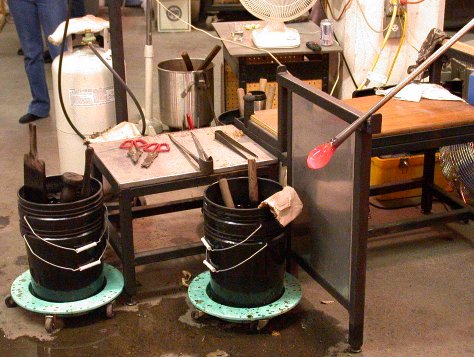 A glass worker's bench is most commonly a steel framed
long armed chair with a wooden seat that extends beyond
the arms on both sides. Below the arms are metal shields
to protect the legs of the worker from the heat of the
glass. The pipe or punty is placed on the arms and rolled
out and back to keep the glass in a smooth round shape
while working it. On the extended seat [or on a small table the same
height] are placed metal
tools, which may also hang on nails driven in the edge,
and behind the seat are often buckets of water holding
blocks and wooden tools. Since sliding tools
must be waxed (jacks) and gripping tools must not (tweezers,
shears), the waxed tools are placed tips to one edge, the
unwaxed to the other. 2004-07-26 A glass worker's bench is most commonly a steel framed
long armed chair with a wooden seat that extends beyond
the arms on both sides. Below the arms are metal shields
to protect the legs of the worker from the heat of the
glass. The pipe or punty is placed on the arms and rolled
out and back to keep the glass in a smooth round shape
while working it. On the extended seat [or on a small table the same
height] are placed metal
tools, which may also hang on nails driven in the edge,
and behind the seat are often buckets of water holding
blocks and wooden tools. Since sliding tools
must be waxed (jacks) and gripping tools must not (tweezers,
shears), the waxed tools are placed tips to one edge, the
unwaxed to the other. 2004-07-26
-
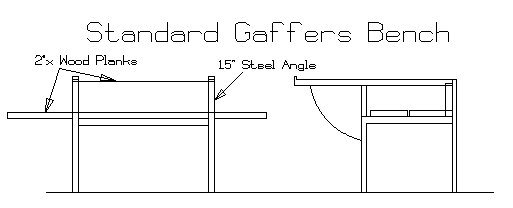
- A bench is a personal choice and may be built from wood
with steel rails or may be built with sloping arms. Having a bad
back, I stand all the time rather than getting up and down, so I use
one that I stand before
with the arms at waist level and the tools underneath the
arms I also find it easier to get
around the end of pieces and place the punty. Some
workers omit the bench and its arms and work glass on
ball bearing rollers.
Marty Johnson prefers a bench with a
higher and angled seat so she can get on and off it quickly, her heels do
not touch the floor when she is seated. 2003-11-14
More benches
- Bit Iron
- See Iron
- Blocks
-
 Blocks are chunks of fruit wood,
most commonly cherry but also pear and apple, which are
carved to a shape useful in forming glass and then soaked
in water until waterlogged. The steam from the water and
the carbon that forms on the surface makes a durable tool to produce
smooth glass.
Usually will crack if allowed to dry out therefore kept in water or in
plastic bag when traveling. Wooden rods and
paddles are also used the same way. Walter Evans makes blocks for
many studios. OLY ** Image at
right from Harvey Littleton's
book Blocks are chunks of fruit wood,
most commonly cherry but also pear and apple, which are
carved to a shape useful in forming glass and then soaked
in water until waterlogged. The steam from the water and
the carbon that forms on the surface makes a durable tool to produce
smooth glass.
Usually will crack if allowed to dry out therefore kept in water or in
plastic bag when traveling. Wooden rods and
paddles are also used the same way. Walter Evans makes blocks for
many studios. OLY ** Image at
right from Harvey Littleton's
book
- "a wooden dipper-like device cut out on one side and used
during free blowing to give symmetric form to a bottle
in its early stages". IGCB
Paper & Wood
Blocks in use. 2003-11-22
- Blow-back mold
- a full-height mold with a bulb-like formation cut into
the neck of the mold to facilitate severing the completed
bottle from the blowpipe. IGCB
- Blowpipe
- see Pipe
- Blowpipe Hose Extension
- The extension slides over the mouthpiece with a 90 degree
swivel connector attached to a 6 foot piece of latex
tubing that is equipped with a mouthpiece. The use of the
extension will enable you to work a piece at the bench or
glory hole without bringing the pipe to your mouth. The
thin tubing also makes clear how little pressure is
needed for blowing properly heated glass. SIWS Blowpipe
Hose Extension (0.5, 0.625, 0.75, or 1.0 inch) $25 Wale
Apparatus, basic mech.+vinyl tubing
- Bucket
-
 Most
studios have a number of buckets around, with or without water in them.
There are four in the image at right, two black ones on roll around stands
holding blocks, one stainless bucket further back and one just peeking past
the corner of the bench seat. These hold the wet tools, wood here,
including a paddle sticking up at the left edge of the photo and the paper
folded over the edge in the middle. 2003-11-22. Crackoff
Buckets Most
studios have a number of buckets around, with or without water in them.
There are four in the image at right, two black ones on roll around stands
holding blocks, one stainless bucket further back and one just peeking past
the corner of the bench seat. These hold the wet tools, wood here,
including a paddle sticking up at the left edge of the photo and the paper
folded over the edge in the middle. 2003-11-22. Crackoff
Buckets
- Burner, Burner Head
- Most furnaces and almost all glory holes are heated with
natural gas or propane driven through a burner head
backed up by plumbing that may be more or less
complicated and include safety features. See BURNER.HTM The burner head is a
matter of commercial contention and may be an open pipe,
a ceramic construction or a similar metal construction. A
head with many holes is designed to be quieter and offer
a greater range of turn up and turn down. A ceramic head
is designed to keep iron bits out of the glass. See Ribbon Burner
A B C D E F G H I J K L M N O P Q R S T U V W X Y Z
- C
Calipers
- A divider or compass like
tool of two arms off a pivot but commonly with curved arms that hook in or
out and primarily used for measurement or comparison. Outward curving
arms are used for inside measurements while inward are used for outside.
When used for measurement, the distance across the tips is put against a
scale. When used for comparison, an existing object is matched to the
new one. Image Lid Calipers 2008-05-20
- Cane Marver
- A marver plate with grooves for
spacing cane evenly to pickup on hot glass. Hard to make
without a metal milling machine, usually bought: Steinert
$60 Aluminum, $95 iron for heating.
- Car Kiln
- More often seen in pottery work although casting places may use it, one
end and the bottom are on wheels (the car) and the unit rolls into the other
four sides forming a box, with a channel of sand to seal the bottom edge.
Allows complete access to bulky stuff while not trying to move the
insulating box (and burners in the case of pottery.) Kiln,
Bell Kiln 2007-03-20
- Casting Ladle
- The casting ladle is made of high grade cast iron and is
designed to be welded to a handle made of 1"
schedule 40 pipe. The ladle is 6 inches in diameter and
will hold up to 7.5 pounds of glass. SIWS - Casting Ladle
$96 A smaller ladle can be made welding a dome cap to
steel tube. see Gathering Ball OLY
- Ceramic fiber blanket, board & paper
- Modern industrial high temperature insulation to replace
much more dangerous asbestos. Available in several forms
and several temperature ranges. Blanket is usually sold
in 100 "board foot" (which is 1 foot by 1 foot
by 1 inch) rolls, so the price given is probably for 1"
thick. The first roll I bought was 48" wide, 2"
thick, and only 12.5 feet long. For the National product,
I have paid well under $100 a roll according to my skimpy
records.. For annealers and most kilns, the lowest
density and the lowest temp rating is all that is needed
and this makes for lower cost. Refractory
- Chair
- Alternate name, historically, for a bench
- where the gaffer sits.
- Clamp
- Alternate holding technique for partially worked glass
GL5K Gimmick,
Sabot
- Clay Pot
- See Pot
- Cold Working
- The general name for sandblasting, grinding and polishing
the glass. While many artists use the procedures of cold
working as part of their artistic creation, most would
prefer to avoid the labor intensive process of grinding
off punty marks and polishing the result. Glass must
always be worked wet, otherwise heat builds up rapidly
and damages the tools and causes cracking in the glass. Grinder, Polisher,
Another page
- Color bars
- Glassblowers using moderate amounts of color in their
glass buy bars of concentrated colored glass about 1"
in diameter and a foot long. This is cut in smaller
chunks and melted, crushed or pulled. Sold by the kilo
for a full bar, cost is effectively $1-3 per inch ($17-48
per kilo.) Those using more color tend to melt their own
to reduce cost and control color values. OLY Color Page
- Color crusher
- Usually a heavy-walled steel pipe with a close fitting
thick steel disk with a handle. Chunks of glass are put
in the tube, the disk placed on top and the handle
pounded with a hammer or just used like a mortar.
Produces dust or small chunks (frit.) A great tool for
making your own glass powders. SIWS - Crusher $80
- Color cutter
- To get color bar into usable sizes, a cold chisel and
hammer will work, often scattering expensive sharp pieces.
A commercial cutter is a guillotine like frame with a
holder for the glass that tries to keep things under
control. Home built in a variety of designs.
- Color oven or kiln
- Any small kiln (or corner of the annealer) used for
preheating chunks of color bars to allow pickup without
cracking. Copper enameling supplier or build, needs very
simple temperature control. Usually has a blackboard near
it to plot layout of various colors which may look
identical.
- Compass
- A tool with two straight arms from a pivot, used today with a marker on
one arm for marking out a circle, but historically in the manner we now use
a divider. 2008-05-20 Image
- Compressor
- See Air Compressor
- Cone
- Pointed tapered tool (cone shaped) Typically 7" long, 3" dia., with handle, Paoli
$30. Wood or graphite, for opening glass shapes and
providing a variable sized round tool for working the
glass.
- Contactor
- A relay-like device used as a noisy power controller or as a safety
cutoff because of leakage through SCR's.
Contactor
- Controller
- When glass has to be held at a specific temperature or
ramped slowly from one temperature to another, some kind
of controller is used. These
days it is usually digital, but mechanical and analog
solid state controllers have been built. Controllers are
available as small boxes under $200 that will ramp and
hold and as more complicated systems that will control up
to 5 or 8 units. Most continuously used studios will have
the furnace under a control along with at least two
annealers and a color oven. Some may have additional
annealers and perhaps small units used as garages for
parking hot glass.
- Cooler
- See Pipe Cooler
- Copa
- "Tool for shaping wraps into round and half round."
Jim
Moore tool Handled tool with a long U-shaped channel that
tapers narrower toward the end.
Another Source
- Cork dust
- is used on metal molds to give a carbon surface. Adhered with
baked linseed oil or special paste sold for the purpose. see below.
- Cork Paddles
- Soft way to massage hot glass for flattening or indenting
sides of blown piece. Unlike most thin paddles, these
have thick round or oval pads of cork and I would be
tempted to call them cord pads if the sellers did not
label them otherwise. CGS $70
to $90 Site
link Or per suggestion on CraftWeb - Alexander Adams - "Next
time you need to make cork paddles or need cork dust, buy a 24" x 12" x 4"
cork slab from McMaster-Carr. In the index it
is listed as Cork Insulation and the item number is #9354K44. It costs about
$18.52 not including shipping. Run these through a clean table saw to make
the cork paddles. Depending on how many cuts you make on the table saw, you
will make plenty of cork dust. If you're picky, you may want to sieve out the
dust that is too big. If your crafty, you can make extra paddles to sell on
E-Bay. Banister Rail, Plywood, Deck Screws and Gorilla Glue are the only
other supplies you will need." 2003-08-07 used with permission An
alternative is
Yoga Cork $9.95 - 9 x 5.5 x 3.5 inch to make two. 2005-04-27
- Cowl Board
- "A wooden face mask used by the furnace tender to protect him from the
intense heat." Collectors Encycl.of
Am.Art.Glass p.225 [MF: In factories, fixed shields used in art
studios.] 2008-05-20
- Crack off table
- See Drop Off Table 2004-07-13
- Crack off bin/bucket
- At the end of each use of pipes and punties there is
usually a collar of glass around the end. This glass will normally
break and shatter off as it cools, perhaps fired with enough
force to hurt people. Therefore the tools are left in
metal (heat proof) buckets or dry bins that capture the
glass. Normally punties have less glass and are placed in
water filled buckets (stainless steel food service
buckets are especially nice). If a pipe is placed in
water without sealing the end, the steam inside almost
instantly makes the pipe too hot to hold, so pipes are
put in steel barrels or flat bins. All crack off catchers
are also used to dump mistakes, broken pieces and scrap
glass. For larger containers a barrel is commonly used.
Often clear glass is separated from colored for reuse.
Stainless steel buckets are very nice, but expensive ($70-85);
stainless steel soup pots are thinner and much less
expensive ($6-12)
- Crimp
- 1. A tweezer like tool with metal pads on the ends that have a pattern.
When hot glass is squeezed between the pads, the pattern is impressed.
A leaf crimp is perhaps the most common, but ribs, circles, shells, etc. are
available. MOORE 2003-06-22
2. A special tool for making Millville rose type
paperweights, it provides the shape of the petals. Color
is picked up on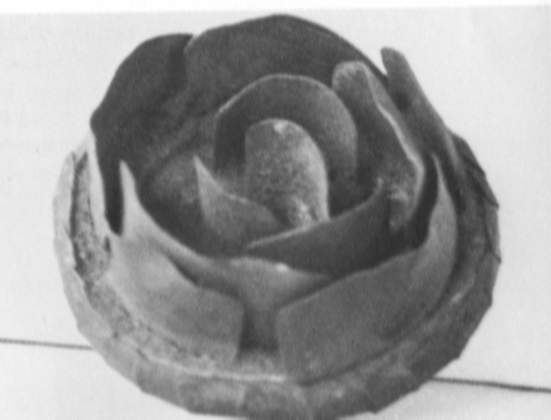 the bottom of clear, heated, and the
crimp is shoved through the color. After the tool is
removed, the base is jacked to taper the rose bottom and
remove the source color, the shape then being puntied at
the base and further encased. If two layers of color are
provided, the tips of the petals shade from one to the
other - pink to red, white to yellow. Crimps are usually
hand made and reworked by the gaffer. Brass is soldered,
the solder protected by plaster of Paris. Thin brass will
melt. [Description and use compiled from several sources,
including GGNJ, Corning Museum Rakow Library notes, and
personal experiments crimp.htm.] the bottom of clear, heated, and the
crimp is shoved through the color. After the tool is
removed, the base is jacked to taper the rose bottom and
remove the source color, the shape then being puntied at
the base and further encased. If two layers of color are
provided, the tips of the petals shade from one to the
other - pink to red, white to yellow. Crimps are usually
hand made and reworked by the gaffer. Brass is soldered,
the solder protected by plaster of Paris. Thin brass will
melt. [Description and use compiled from several sources,
including GGNJ, Corning Museum Rakow Library notes, and
personal experiments crimp.htm.]
3. Crimper "A wooden form that is used to give a bowl or pitcher a crimped
rim." Collectors Encycl.of Am.Art.Glass
p.225
- Cullet
- Broken glass, which melts easier than batch.
Can be remains of previous work, bottles, or purchased.
The latter two may need chemical additions to make more
workable. Available from Gabbert Cullet
and other sources. More here
- Cutter, Color
- An ongoing problem for blowers is cutting the color rods, which are
usually about 1" in diameter and are often used in chunks about an inch
long. They are very hard and very brittle and some of the methods used
scatter color chips far and wide. Guillotine arrangements, cold chisels,
etc., have been used. People who have one may
use a cutting saw. More
A B C D E F G H I J K L M N O P Q R S T U V W X Y Z
- D
- Diamond Shears
-
 Special pliers with a sharp diamond shaped opening for
cutting Hot Glass Bits and, usually, a round
opening at the tip for controlling punties, pulling
glass, etc. Shown at second from left at right. From Steinert $90. See also Shears Special pliers with a sharp diamond shaped opening for
cutting Hot Glass Bits and, usually, a round
opening at the tip for controlling punties, pulling
glass, etc. Shown at second from left at right. From Steinert $90. See also Shears
Sample cheap tools on
the marver - no jacks shown.
- Dip mold
- a one-piece mold open at the top. IGCB
- Dividers
- A tool consisting of two straight arms attached to a pivot. Used
for "walking" off distances on charts or for construction as an alternative
to scaled measurement. Greeks doing math would call them a
compass. Lid Calipers
CalipersImage 2008-05-20
- Dowel, Wood
- Wooden dowels can be used alone or in large tweezer-like
handles. From woodworker supply catalogs in cherry 1/8"
to over an inch. Wood
- Drill, Drill Bit
- A tool for putting round holes in cold glass, the drill
actually being the thing with the motor while the bit is the
variable sized added piece that does the cutting. Covered
in Coldworking including drilling
& cutting glass
- Drop Off Table
- When working glass, it is nice to have a partner, assistant, etc., who
can glove up, take the piece while on the punty and carry it to the
annealer. Some people (me) working alone will take the piece on the
punty, having chilled the join, and place it just above the floor of the
annealer, rap it off (note it is upside down, instead of sitting on its
bottom as it would if a gloved placement were used.) After one has
seen a piece pass between the hands of the assistant and crash on the floor,
one considers a drop off table. This is nothing more than a rimmed
table top, perhaps 18" square, padded with an inch or more of frax blanket,
vermiculite
or fiberglass. It may roll around and store gloves, knock off tools and
other stuff underneath. A metal prop may support the punty if the
table is wood, not metal. The glass is rapped off the punty onto the
table and then carried to the annealer by the gloved blower working alone or
caught above the table by the gloved assistant. 2003-09-05, 2004-07-13
- E
Extruder
- A tool or piece of equipment which applies pressure to a bulk of soft
material to force a relatively thin rod or tube shape out a small opening
shaped to form the rod. Used in industry for food (pasta, filling casings),
plastic, metal (aluminum window frames, etc.) and clay (bricks, pipe),
in art the primary use is clay where it can form the bulk of a shape or
provide a hollow body for further work. Small homemade
extruder Use in glass is limited due to the
high temp and free flow of glass which drops off as blobs. 2011-10-05
- Eye Protection
 Every glass worker should have several
levels of eye protection. At a very minimum break
resistant glasses to save the eyes from glass fragments.
Furnace workers, according to tests, should be using at
least a #3 and preferably a #4 welders shade to observe
the furnace and glory hole. I do this with a relatively
low cost ($25) plastic shield on a Jackson 170-S (not the
newer 170SB) head band with Glendale Irex (Blue Diamond)
862 shield stocked in #5. Grainger offers the Sellstrom 39150 Shade 5
face shield complete $23.09, their # 1N785 The full face shield is also
nice in holding off the heat, but I
got the idea from a couple in Michigan who cut off the
lower half of the shield so they don't have to raise it
to blow. Some workers wear welding clip-ons or use a flat
piece of welding glass in a frame at the yoke to look
through. According to tests, UV is not a problem, IR is
too high and protective choices should be made. Many
glass workers use sun glasses or nothing. Every glass worker should have several
levels of eye protection. At a very minimum break
resistant glasses to save the eyes from glass fragments.
Furnace workers, according to tests, should be using at
least a #3 and preferably a #4 welders shade to observe
the furnace and glory hole. I do this with a relatively
low cost ($25) plastic shield on a Jackson 170-S (not the
newer 170SB) head band with Glendale Irex (Blue Diamond)
862 shield stocked in #5. Grainger offers the Sellstrom 39150 Shade 5
face shield complete $23.09, their # 1N785 The full face shield is also
nice in holding off the heat, but I
got the idea from a couple in Michigan who cut off the
lower half of the shield so they don't have to raise it
to blow. Some workers wear welding clip-ons or use a flat
piece of welding glass in a frame at the yoke to look
through. According to tests, UV is not a problem, IR is
too high and protective choices should be made. Many
glass workers use sun glasses or nothing. - F
- Ferro, Ferritti
- The flat plate and short rectangular bars used for
heating cane in a glory hole in Italian work. Plate
carried with a Pastorali
- Files
- Most glassblowers have at least a couple of files around,
often rusty from being too close to the water used with
wood tools. A file can be used to notch the glass of a
heavy neck on a piece to increase chances of it coming
off cleanly. Normally, only the corner of the file is
used on the glass.
- Fingers Hot Fingers
- A form of gimmick for holding small glass objects
including marbles, more often used in torch work
http://www.arrowsprings.com/html/holding_tools.html#hotfingers but
can be made larger. 2008-10-18
- Fire brick
- A brick made to withstand high temperatures, costing more
the higher the temperature, from $1.50 to $25 a brick.
Usually very hard and heavy, a poor insulator. Available
in many shapes. Used for furnaces mostly. See also Fire brick, Insulating. From A.P.Green,
Mexico MO and local offices, National Refractory, see
Refractory in Yellow Pages. [8-1-2000 Recently A.P.Green
was purchased, so name changes are in progress.]
- Fire brick, Insulating
- A very light, soft, easily cut, high temperature material
than can form structural walls for kilns and backup hard
fire brick. It is possible (carefully) to pick up with
the hand an IFB that is at 1000-2000 on one side - I
always use gloves because of other heating effects, just
in case, but I used a brick for a door on a small glory
hole, moving it with a leather gloved hand to get at the
hole.Refractory
- Flame Sensor
- A safety device used to insure that a flame actually
exists when the equipment wants one. Two forms are a
Purple Peeper that looks where the flame to sense the UV
in a flame that does not exist in a hot wall, and a
thermocouple like device that sits in the flame and
detects both the heat and the conductivity of the flame.
Part of the combustion train.
- Footer, Footing Tool
 Tool
for shaping the thin flat foot of a goblet. Most commonly
a pair of thin (1/4") fruit wood (cherry) boards
about 3" by 4" (75mm x 100mm) hinged on one
long edge with a slight semicircular dish sanded/cut into
the face of one board along the opposite edge from the
hinge with a notch cut for the stem. The wet tool is
gripped in the palm of the hand and brought up to the hot
glass foot gather and the boards closed around the glass.
The dish forms the upper side of the foot, the flat board
opposite the bottom of the foot. Footer at right, with
three different sized cutouts, from Harvey Littleton's
book. Also made with handles and with graphite pads,
costing about $250 Artco, OLY gls-tech.htm#GOBLETS Tool
for shaping the thin flat foot of a goblet. Most commonly
a pair of thin (1/4") fruit wood (cherry) boards
about 3" by 4" (75mm x 100mm) hinged on one
long edge with a slight semicircular dish sanded/cut into
the face of one board along the opposite edge from the
hinge with a notch cut for the stem. The wet tool is
gripped in the palm of the hand and brought up to the hot
glass foot gather and the boards closed around the glass.
The dish forms the upper side of the foot, the flat board
opposite the bottom of the foot. Footer at right, with
three different sized cutouts, from Harvey Littleton's
book. Also made with handles and with graphite pads,
costing about $250 Artco, OLY gls-tech.htm#GOBLETS- Footsitter Shears
- A term used in a query to MF, something I have not seen
to my best recollection, for a tool doing the same thing
as a Footer (above.) Essemce ? [apparently not,
makes a footer, but not shears form.]
- Fork
- A long handed tool for placing and handling glass in the
annealer and garage, typically with the fork rods covered
with frax or fiberglass to reduce thermal shock. Can be
welded from rebar. CGS sells 7'
forks in 3 styles for $40 each.
- Frit
- Chunks of broken glass the size of raisins to grape nuts;
bigger than powder. Can be bought. For smaller
quantities usually made with crusher if color bar is on
hand.
- Fuming Chamber
- A barrel or box with an exhaust fan and filter, used for
applying chemical effects to the surface of the glass,
when the fumes or dust are potentially poisonous.
- Furnace
- Place for melting glass, built of several kinds of high
temperature (refractory) materials to hold the glass and
hold in the heat without breaking down during the several
months that furnaces usually run. See also Tank,
Pot Furnace, and Refractory.
Furnaces
A B C D E F G H I J K L M N O P Q R S T U V W X Y Z
- G
- Gadget
- A tool for holding the foot of a glass, so a punty does
not have to be used, speeding work. (GGW) a tube with
three spring steel "fingers" that extend. May
also be a special tool for a specific shape, as inside a
production vase for footing (GGNJ) Gimmick
- Garage Glass Garage
-
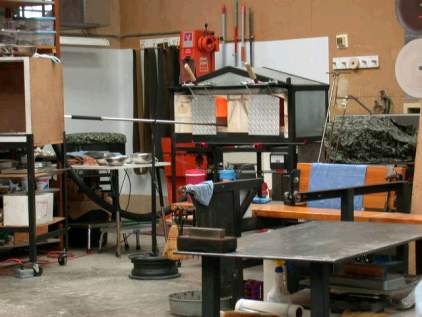 During the working of glass, it is sometimes useful to
park the glass at or above the annealing temperature (about 900-1000ºF),
until some other work is done. While this can be done in
an annealer, having a smaller space with specially
designed doors can be useful in that it avoids damage to
glass in the annealer and can allow glass still on the
pipe or punty to park in the garage, the pipe extending
through a split door. Notes on my
garage During the working of glass, it is sometimes useful to
park the glass at or above the annealing temperature (about 900-1000ºF),
until some other work is done. While this can be done in
an annealer, having a smaller space with specially
designed doors can be useful in that it avoids damage to
glass in the annealer and can allow glass still on the
pipe or punty to park in the garage, the pipe extending
through a split door. Notes on my
garage
-
-
- Gathering Ball (Rod, Iron)
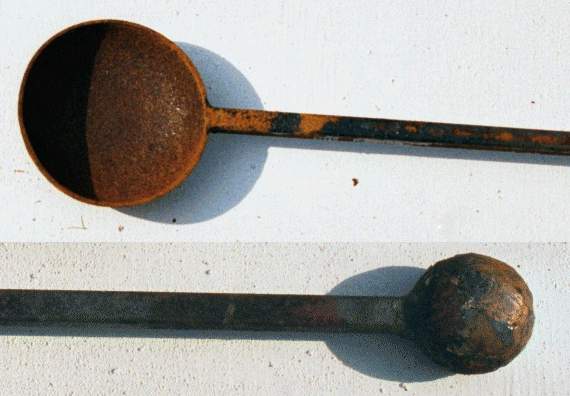 A hollow ball on the end of a punty rod
used for gathering more glass more quickly than can be
picked up on a punty in two or three gathers. Used for
small casting gathers and for cookies. Can be bought or
welded from small dome caps. The image shows opposite
ends of a 6' long 1/2"square tube with a large dome
cup welded to one end and a ball of small dome caps on
the other end. OLY,
Putsch $25-45 Shells and solid iron balls
available from King Architectural Metals. A hollow ball on the end of a punty rod
used for gathering more glass more quickly than can be
picked up on a punty in two or three gathers. Used for
small casting gathers and for cookies. Can be bought or
welded from small dome caps. The image shows opposite
ends of a 6' long 1/2"square tube with a large dome
cup welded to one end and a ball of small dome caps on
the other end. OLY,
Putsch $25-45 Shells and solid iron balls
available from King Architectural Metals.- Gathering Ring
- A clay ring floated on a large tank furnace. Once the
crud is gathered from the area inside the ring, it
keeps other surface crud from floating in to the space.
Normally not used in crucible furnaces because of the
smaller surface area.
- Gauge, Gage
- A tool, often of fixed shape, for measuring the size of
something, like a cutout of sheet metal the matches the
opening or shape of a production goblet. Also a dial
displaying temp, pressure, etc. Also a measure of
thickness or diameter of metal, as 16 gauge metal, based
on an indirect measure, such as weight per square foot or
a hole in a plate made in 1860 (as wire gages are.) Caliper Dividers
- GFCI
- A Ground Fault Circuit Interrupter is a safety
device on high voltage (120-240 volt ac) circuits,
causing an interrupt when the current out differs from
the current returning by more than a small amount, which
is assumed to be leaking through a human body (but which
may be leaking through water soaked insulation.) Electrical/GFCI
- Gimmick
- A device made to assist in making a piece, usually for holding
glass instead of a hot punty, but may also be a neck
former, lip shaper, etc., that performs a special purpose function. Sabot, Snap 2003-07-01 gripper.htm
Mechanical assistance to a greater or lesser degree may also be used. This
video page shows a
major device for handling a large amount of glass along with several
additional devices including and automatic gaffers bench, rotary kiln and
pneumatic molds. This page shows a large
team handling a mass of glass with a large wheel on the pipe and a pivoting
yoke. 2011-02-16
- Glory Hole
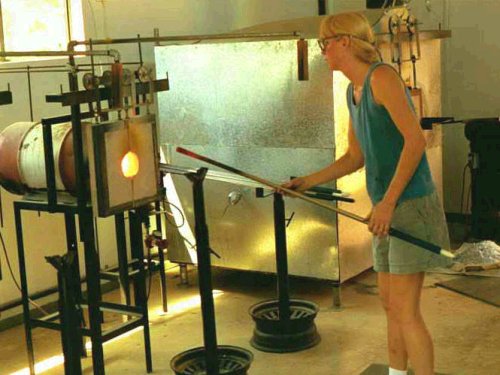
- A place for reheating glass. In commercial shops may be
part of a large multi-pot furnace, but in small shops
is usually a separate structure. Usually hotter than
holding temperature of glass furnace and shut off
overnight while furnace is cooking. Usually shop built
from a barrel with castable or fiber or framed with
bricks. Uses more fuel than furnace, shut down when not in use. At
right, small Glory Hole and Yoke in use at Zero Gravity,
encased furnace in background.
Link to image of huge old (1850's) one and
page with several sizes of glory holes.
Also referred to as a reheating chamber because gloryhole is a sexual
reference for some people. 2010-08-13 The Oxford English Dictionary cites a
first use of the term Glory Hole in 1849 "The large goods receive a final
reheating at the mouth of a pot heated by beech-wood, and called the Glory
Hole" Pellatt Curios. Glass Making p.65 "Beech wood is an excellent
firewood, easily split and burning for many hours with bright but calm
flames." Wikipedia Beech 2011-03-18
- Gloves
- Hot shops normally require two kinds of gloves: leather
welding gloves for handling ordinary hot materials and
ceramic fiber/Kevlar for handling hot solid glass in the
600-1000°F. The latter are fairly fragile, should be
preheated to drive off moisture and reduce thermal shock,
and should not be used for tough jobs. They cost about $60
a pair. Leather welding gloves are padded all around and
have long cuffs and only cost about $8-10; when heated
they will get stiff. Leather palmed work gloves may also
be useful for handling cold glass with sharp edges.
Overmitt Old gloves are a common source for tips of grippers (the
fingers) and for
pockets for setting down glass.
Discussion of gloves
2010-08-13
- Grinder
- Cold working equipment for shaping glass roughly before polisher is used. A grinder may be a
flat disk, a vertical wheel or a belt. The first is used
with either grit applied with a water supply or a diamond disk or
pad, while wheels and belts have attached grits. Glass
must always be worked wet, otherwise heat builds up
rapidly and damages the tools and causes cracking in the
glass.
- H
- Hanger, Pipe Hanger
- Used to hold a pipe/punty vertically with the glass
below, to center and cool glass and act as an extra hand.
A V-shaped slot at about head height. Most pipes and
punties are provided with a shaft or hanger collar around
the shaft near the handle. The hanger must have a tapered
shaped opening for various sized pipes and project enough
from the support so a large piece will not hit. Cooling
of paperweights in particular, so the surface will not be
scarred by handling or the annealer, may take five
minutes or more. Homemade from scrap.
- Hanger Ring
- See Hanger
- Hot
- When the eyeballs seem to have a baking sensation. In
Texas at the end of August 2000, when the air temp gets
up to 105°F and no wind is blowing. In glass work when
too much time is spent looking at a 2250°F glory hole
without eye protection. In NOAA weather forecasts, when the temp
hits 99F.
A B C D E F G H I J K L M N O P Q R S T U V W X Y Z
- I
- Iron
- Apparently British usage, Blow Iron, Bit Iron, Punting Iron
The National Glass
Centre - Glossary Steinert uses Bit Iron
for a punty with a small shaft (1/2") and a larger head (3/4" or 1") which
would be convenient for a larger gather when it did not have to be used on
the bench (where the step gets in the way and the small shaft is hard to
turn.) Steinert's are the same length as punties (54"). I have
learned that Finnish glassworkers use a shorter (1m) tool that translates as
spike for bit gathering. 2005-08-19
- J
- Jacks
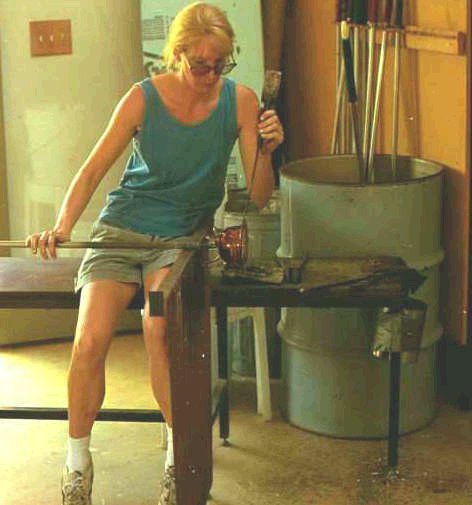 A
hairpin shaped tool that springs open and when closed has
long blades that are parallel about 12-15" long used
for shaping glass. All parts of the tool are used by
skilled glass workers, but the blades get the most use:
closing in the narrow neck of the piece on the pipe and
working the opening of lips. Blades may be nearly knife
edged or rounded. Jacks are also made to hold round (replaceable)
paper or wood "blades" - pacioffis
another image A
hairpin shaped tool that springs open and when closed has
long blades that are parallel about 12-15" long used
for shaping glass. All parts of the tool are used by
skilled glass workers, but the blades get the most use:
closing in the narrow neck of the piece on the pipe and
working the opening of lips. Blades may be nearly knife
edged or rounded. Jacks are also made to hold round (replaceable)
paper or wood "blades" - pacioffis
another image- Jim Moore is considered to make the best in the US, about
$150; OLY; the Italian Dino is
supposed to make the best in the world, $250, buy through
Pilchuck.
- K
- Kanthal (Nickel-Chromium Alloy, 80% Nickel/ 20%
Chromium)
- A higher temp version of nichrome to
be used when a box must be taken up to fusing, casting
and melting temperatures. Beyond Kanthal (a brand name),
silicon carbide rods (and higher voltages) must be used.
- Kiln
- Kiln is an alternate name for oven. A color kiln or
annealing oven may be referred to with the other name. In
the glass studio it is usually electric. While an
annealer usually can't get much above the annealing
temperature (about 1000F), a kiln is usually expected to
be able to get to fusing temps or higher (1500F) The most common forms
resemble chest freezers with the door on top and refrigerators with door on
the front although sliding lids have been used. see also
Lehr, Bell Kiln, Car Kiln
2007-03-20
- Knives, Knife
- Most glass workers have an ugly old knife of some kind, perhaps
"borrowed" from the kitchen. The thin edge and the point are used to reach
in between the punty and the piece to chill small points to start separation
of the piece.
- Knock off table
- Drop off table
- L
- Lathe
-
 A lathe is a horizontal motorized turning device. There
are two kinds of lathe involved in glasswork. One is a
large bedded device with two rotating heads used mostly in scientific glass working and
handles tubing, especially large tubing, keeping two
pieces turning and aligned while they are torched for
joining. The other is the more delicate tool holder used for copper wheel
engraving. 2005-12-19 A lathe is a horizontal motorized turning device. There
are two kinds of lathe involved in glasswork. One is a
large bedded device with two rotating heads used mostly in scientific glass working and
handles tubing, especially large tubing, keeping two
pieces turning and aligned while they are torched for
joining. The other is the more delicate tool holder used for copper wheel
engraving. 2005-12-19
- Lehr Leer
- A mechanized annealing oven that is at high heat at one
end and air temp or nearly so at the other. A conveyer
carries glass pieces the length over the time needed for
annealing. Saves the energy of reheating and the wear and
tear of a heat/cool cycle that an oven requires, but only
cost effective in a heavy production shop. Sometimes lehr
is used as just as a name for a cooling oven. In an old
time shop, the pieces are moved by hand from zone to
cooler zone. [2003-10-07 When a person asked by e-mail, I went and
looked for lehr and annealer in the Oxford English Dictionary microprint
edition that I own. Lehr does not appear, while anneal and related
words get a column with references back to the 14th century all related to
heating and burning china, glass, or metal. I am now guessing that
lehr is a jargon term out of the last syllable - as "Put that glass in the
annealer" becomes "In'th lehr"]
- Lid Calipers
- Used for gauging an inside diameter against an outside
diameter, as in a lid that must fit inside or fit outside
of a bottle or jar. Usually X shaped with inwardly
curving tips on one side and slightly outwardly curving
tips on the other, the tip contact points being
the same distance from the pivot. Available from ceramic
suppliers. Calipers Dividers Gauge
- M
- Marver
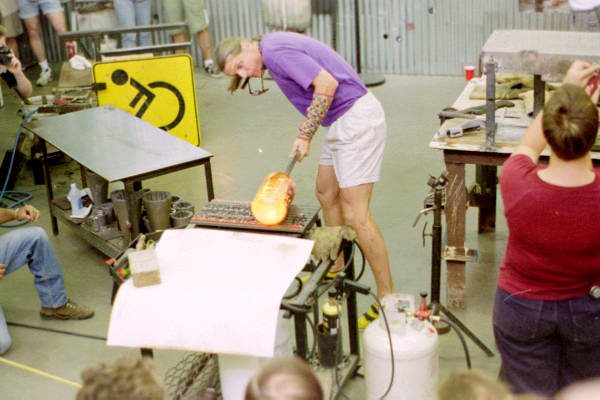 Metal,
marble or graphite plate, most often steel, used for
rolling glass to a cylinder or cone and chilling the
surface to firm it for blowing. Should be large enough to
roll largest piece over a more than one turn (over 2' for
8" piece) Some marvers are mounted at an angle or
are adjustable to an angle which makes for easier work
when many pieces are to be made with a tapered shape. A
marver may have textured surface (see also Cane Marver . ) Homemade $10-35
from steel scrap yard, or Steinert $75 textured 16"
long. Metal,
marble or graphite plate, most often steel, used for
rolling glass to a cylinder or cone and chilling the
surface to firm it for blowing. Should be large enough to
roll largest piece over a more than one turn (over 2' for
8" piece) Some marvers are mounted at an angle or
are adjustable to an angle which makes for easier work
when many pieces are to be made with a tapered shape. A
marver may have textured surface (see also Cane Marver . ) Homemade $10-35
from steel scrap yard, or Steinert $75 textured 16"
long.
Stephen Powell using marver to pickup colored murrini on
hot glass at '97 GAS Conf. - Mashing Pliers
- Pliers with pads on the end to shape glass, see crimps
- Mold
- A wet or dry form for shaping glass. Dry forms can be
metal, plaster, clay or wood. Wet are wood or metal. Dry forms may
have carbon (from acetylene flame) on the inside.
Molds - Wood & Metal
The most widely used molds are thick cherry wood bowls,
often with handles, used for providing the primary shape
when blowing and for paperweights. Since the bowl size
constantly changes as the wood burns out in use, small
bowls become larger. Other fruit wood may be used. BLOCKS
A variety of other molds are used for blowing into,
usually they are on the floor and the worker stands over
them, then are split to open and remove the glass. OLY CMS
- Mud
- wax mixture used to lubricate steel tools to keep from marking glass,
may include carbon black and various waxes, mostly bees wax and carnuba, a
harder wax.
- Muffle
- a small furnace. IGCB used for
baking painted labels and probably for heating,
preheating and garaging In ceramics, a burned fuel (non-electric)
kiln with indirect heating, therefore a muffle wall to block the flame. MF
A place for heating materials without direct action of the fire.
GL5K 2005-11-28
- Murrini Cutter
- Like a color cutter used for taking slices or chunks
off a rod, but with murrini there is a need for more precision to preserve
the image in the murrini and the losses must be low. Thus devices are
air driven for a snap action with opposing hard shape edges. 2005-03-09
A B C D E F G H I J K L M N O P Q R S T U V W X Y Z
- N
- Newspaper
- Used for shaping glass when formed, wetted and held in
the hand, to replace a marver, mold or block.
Most often made from 4-5 sheets of full
page newspaper, folded first in thirds, then the long ends are tucked into
each other and the corners cut for flexibility and drainage. The result is
flattened and water soaked then drained just before use.
The water keeps the paper from burning and the shape is
controlled by the shape of the hand. Paper marver is used for cylinders
and glass rolled in place, not along it. People who like wood
blocks often hate newspaper while those who use newspaper
think wood is inflexible and expensive. Around Seattle in 2003, people
seem to like very thick pads, not the 4 sheet version. According the
legend, the paper of the New York Times is especially
good at not turning to mush. Wood & Paper
V-Block
- Nichrome (Nickel-Chromium Alloy, 60% Nickel, 16% Chromium (Balance Iron) )
- A wire especially made for heating elements. It
withstands the red hot temperatures without oxidizing to
nothing and without melting. It does, however, get
brittle when heated so it is fairly easy to break a coil.
The size of the wire and the closeness of the coils
determine how hot the element gets and therefore the
heating point of the element. Thin wire has more
resistance and gets hotter for the same current (at higher
voltage.) Coils close together reach a higher temp than
those stretched out. People who work with the wire wind
coils after figuring the total wattage needed and the
length of the space for them to be installed. Eagle used
to make 1000 watt replacement coils, but has stopped and
all the stock is at Elliott's Hardware in Dallas, Texas.
Many people use electric dryer heating elements for
annealers, which is fine, but Nichrome can not be taken
up to fusing and casting temps (1450-1650F) without
sagging and losing it. Kanthal A-1 or
equivalent must be used.
Nichrome can also be used embedded in glass for hangers,
more often fusing than blowing, but it is compatible.
- O
- Optic
- A cylinder, open or closed on the bottom, with even
ridges and groove around the inside, used to produce optical effects
and air stems. Chills glass which can then be twisted,
etc., and pattern remains in glass. Also used for
applying threads of color, which are carefully laid
inside the optic before the glass inserted. Usually
aluminum, almost impossible to home make, Steinert
offers two dozen varieties at $45-100. Almost anything
with an even pattern inside (a spline in a gear) can be
used. An optic for shaping glass only, not holding
stringer, can be made by welding rods or plates to form
an inner cone or other shape. One example of a plate
version can be seen at www.glass.co.nz/glruby.htm
- Ornament Holder, Pocket, Bowl, or Scoop
- When hand making ornaments, the hanging loop can either be wire added
later, like commercial Xmas ornaments or it can be a glass loop. When
making the latter, one cracks off the ornament from the pipe, applies a hot
bit, blobbing it a bit to seal the hold, pulls, cuts, and loops the bit to
touch the blob. Tweezers can be used in forming and shaping the loop
and once it is firm, they can be used to pick the ornament up to place it in
the annealer. So where does the 1100°F ornament sit while the loop is
being applied? Usually in a nest made of a piece of frax fiber in a
bowl the right size. But it may just rest on a drop
off table or be
placed in scoop from which it can be rolled into the annealer.
2003-09-05
- Overmitt
- When Kevlar gloves are used to handle hot glass, they
both get damaged and over heat, prompting the user to peel them off as soon
as possible. One way to avoid/reduce this is to pull on a mitten shape
that adds extra thickness and takes some of the damage, but makes the hands
more into paws. But then, when used, one is usually just clutching
glass at 1100F or so, so fingers are less needed. 2003-09-05
- Oxygen Generator Concentrator
- A device which uses electricity to extract pure
oxygen from water or air. In the former
case, may also supply hydrogen. In the concentrator
form, tanks
of chemicals absorb the nitrogen in the air resulting in a higher
concentration of oxygen. In both cases the quantity is limited by the watts
available and since these are used to reduce the dependence on tanks,
normally they are used for torch working (as well as health needs.)
2009-07-26
- P
- Paddles
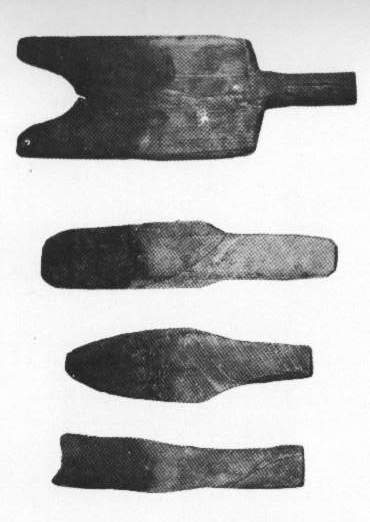
- Boards with handles, fruit wood, usually cherry,
sometimes graphite or metal. Used for flattening glass
and for shielding gaffer's arm. Homemade $5 stock at
hardwood/woodworkers shop. A.R.T.Co $8-14, Paoli $15.
Graphite: Moore $40, Paoli $35. A Tagliol
Paddle is a metal handled, thin metal bladed handle
used in traditional Italian work, especially for cutting
and shaping sculptural work. $55-70. CGS sells 4' handled flat
rectangular paddles for moving items in a garage and also
sell thick cork paddles. Image at right is some well used
paddles shown in Harvey Littleton's
book.
- Pacioffis (Cutting Edge) Parchoffi (Moore, Palmer) Rod
Tongs (Putsch)
- Wooden tipped jacks used to open
pieces without leaving jack marks on the glass. "I
made some a couple of years ago. They are soaking in
water somewhere in the shop." Terry Maxwell. MF
uses cherry wood dowels from woodworking catalog, as
singles, not pairs, various diameters. Image
- Paste Mold
- A metal mold that has been treated with a baked on
compound, special or linseed oil and cork, so that it has a soft finish that
can be soaked in water but is much more durable than wood. 2003-08-20
- Pastorale, Pastoralli, Pastorali
- "An Italian term for the metal tool on which pieces
of cane get preheated in the glory hole or furnace. Don't
have one of these. If I'm going to pick up canes or
inclusions I usually place them on a cane marver and heat
them with a torch. Another alternative is to set the cane
marver on a hot plate and let it heat up." TM Steinert
refers to heating iron cane marvers.
Video showing use
"Confused Boy [says],
This came from Dick Marquis in person. The forked thingy
is the pastoralli and the plate is the fero. He has
forgotten more than I know so I would take his word for
it. Peet "
A flat steel or ceramic plate used for heating bits in
the glory hole, along with a tool to carry the plate and
often a mounted head to allow setting down the plate,
turning it 180° and picking it up to evenly heat. Used
for preheating and partly fusing cane and other elements
for glassblowing. Metal is traditional.
- Pastoralli Carrier - 5" x 8 3/4' x 5' overall
length, $200.00
Pastoralli Carrier 3" x 6"x5' overall length, $165.00
Small Pastoralli plate, 5" x 9", 5 grooves per
inch, $120.00
Large Pastoralli plate, 7" x 13", 5 grooves per
inch, $130.00
PLATE SPINNER, Makes setting hot pastorelli plate down
easier. $200.00, HUB
Correll agrees, spelling the "forky thing"
pastoralli and crosses the fork prongs, so the end is a
rectangle, while calling the plate a ferro and the bars
for holding the glass a ferritti.
Pastorali, 6' $130; Ferro 6"x12" $75, 8" x
18" $95; Ferritti 3 1/2" x 3/8" set of 6 $15.
CGS
- Pallet
- Apparently a
British term for paddle
- Pi Dividers
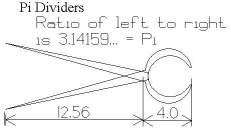 Used to measure a
straight length that will wrap around a circular shape.
Usually made as a pair of curved jaws on one side of a
pivot with straight divider arms on the other. When the
curved jaws touch the outside diameter of the circular
item, the straight arms are 3.1415926... as far apart.
Photo
of Jim Moore's version
Video showing use Calipers
Gauge Used to measure a
straight length that will wrap around a circular shape.
Usually made as a pair of curved jaws on one side of a
pivot with straight divider arms on the other. When the
curved jaws touch the outside diameter of the circular
item, the straight arms are 3.1415926... as far apart.
Photo
of Jim Moore's version
Video showing use Calipers
Gauge- Pick
- Most glass workers have a sharp pointed pick, often bent
at a right angle at one end and straight at the other. It
may be a commercial scribe or be hand made. It is used to
open tiny holes nothing else will get in and to draw
threading in the feathering technique. Beadmakers use a
titanium pick, hard and stands heat.
- Pipe Brush
- This tool can help eliminate the problem of metal flaking
in the head of your blowpipe. Use this tool on a cold
pipe.
- Pipe, blowpipe
- Used for blowing glass, tube with mouth piece on one end, used for picking up
glass on other end, originally of iron/steel, usually today made of low conduction
stainless steel although in 2003 there is a revival of carbon steel
tubes claiming more stiffness and better grip, also cheaper, still with
stainless heads. All pipes flake iron oxide to some degree, SS does it less,
bits can get in glass and burn lips when pipe is raised to blow. Can be as simple as 1/4" IPS
pipe, but usually is a thin wall 5/8"-3/4" tube
with a tapered metal or plastic mouthpiece and a nearly
solid flared pickup end for better glass support.
- While most of the pipe is thin wall
tube, the end that takes the glass is usually turned from
heavy rod or thick wall tube to a flared shape with a small hole (thus being
very thick walled at the end) to provide support for
pieces and to make it easier to form the initial bubble.
The other end is usually a tapered metal or plastic
mouthpiece with moderately thick walls and a small hole. Pipes are
commonly made with wall thickness of 0.062, 0.090 and 0.120 inch. The
most common outer diameter is 0.75", [0.540-1.0"] with 0.75" or 1.0" heads
[.75-1.5"] Commonly 54" long [52-58"] Product Ref.
$20 homemade to $150 Steinert.
Custom length and head size are fairly easy to get. 2003-07-07,
2007-05-09
- Pipe Hanger
- See Hanger
- Pipe Cooler
-
 A method of quickly applying water to a pipe which has
gotten too hot to handle often from gathering low glass in a furnace. Can range from a wet rag to a
dedicated spray tube with a foot switch, but the most
common pipe cooler seems to be V shaped box with holes in
the bottom, notches on the bottom of the ends to fit the
pipe, and a handle across the top. It is sunk in a barrel
of water to fill, removed, the pipe laid across the
barrel, the cooler placed and moved back and forth on the
pipe until the water drains out. Wet rags or tubing with
pumped water can also serve. Homemade A method of quickly applying water to a pipe which has
gotten too hot to handle often from gathering low glass in a furnace. Can range from a wet rag to a
dedicated spray tube with a foot switch, but the most
common pipe cooler seems to be V shaped box with holes in
the bottom, notches on the bottom of the ends to fit the
pipe, and a handle across the top. It is sunk in a barrel
of water to fill, removed, the pipe laid across the
barrel, the cooler placed and moved back and forth on the
pipe until the water drains out. Wet rags or tubing with
pumped water can also serve. Homemade
- Pipe Warmer Pipe Heater
-
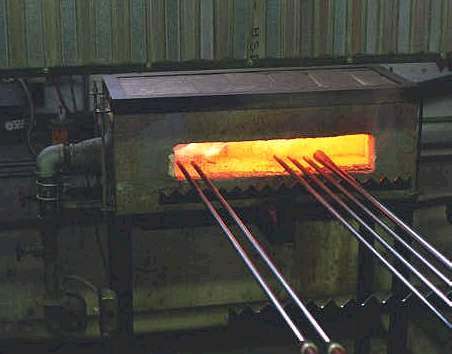 Molten glass will not stick to cold
metal. While it is possible to preheat the pipes and
punties at furnace or glory hole, most studios have a
rack to hold them in position in a dedicated flame or the
exhaust from furnace or glory hole (or at the glory hole
door in cheap situations.) Ideally, the warmer has a
range of temperatures so placement of a punty with glass
color on it will neither drip or chill to cracking, so
the gather of color can be reused. Must have something to
allow for glass cracking off pipes/punties placed in it - a
tray, etc. Molten glass will not stick to cold
metal. While it is possible to preheat the pipes and
punties at furnace or glory hole, most studios have a
rack to hold them in position in a dedicated flame or the
exhaust from furnace or glory hole (or at the glory hole
door in cheap situations.) Ideally, the warmer has a
range of temperatures so placement of a punty with glass
color on it will neither drip or chill to cracking, so
the gather of color can be reused. Must have something to
allow for glass cracking off pipes/punties placed in it - a
tray, etc.
- Polisher
- A wheel, belt, or disk used for putting the final finish
on glass during cold working. A tool
called a reciprolap is a horizontal and semiautomatic
grinder and polisher of flat bottomed paperweights, etc. where the disk
goes round and round off center and the pieces turn as they touch the padded
edge.
Wheels for polishing are usually felt, fairly large in
diameter and used with cerium oxide, pumice and other
fine abrasive compounds to leave a clear finish. Glass
must always be worked wet, otherwise heat builds up
rapidly and damages the tools and causes cracking in the
glass.
- Pot
- A ceramic clay bowl shaped holder for molten glass, usually removable
for replacement when eroded or cracked. Must withstand weeks or months
of sustained heat while not losing chunks onto the glass or dissolving too
much. Pots with these features are brittle and require slow heating and
cooling to prevent shattering. In older factories, lower technology
pots were replaced weekly and making new ones was a considerable function of
a department of the factory. A pot may hold from a few dozen pounds to
several tonnes of glass. Glass weighs about 150 pounds per cubic foot and
doubling the dimensions of the pot increases the capacity eight times.
2008-05-21
- Pot Furnace
- A furnace using one or more crucibles (pots) for melting glass. (see
also Tank) In colonial American and equivalent European
factories had six, eight and ten pots in the furnace each holding hundreds
of pounds. The pots were made and fired in the factory and replaced by
removing a section of the hot furnace wall. Pot furnaces are used now in art
studios and some factories and for melting small (10-20#) to large
(150-250#) quantities of color. Pots are always batch mode: cullet or batch
glass is added (usually in the evening) and must be melted before working
can begin. Pots may be invested by casting insulating material or free
standing in the furnace.
Homemade with crucibles purchased. Furnaces
- Powder Cup, Powder Box
- Colored powder is applied to hot glass by rolling the
glass in a layer of the color. The layer may be on the
marver or in a metal pie pan, but many artists like to
use a brass or aluminum molded color cup to hold the
powder (and move it out of the way) and shape the glass.
One interesting alternative is to use the heavy metal
scoops used for ice and other institutional food
products; one artist used insulating castable to mold
several hollows in which to set the scoops and allow them
to be changed out. A powder box has ventilation to suck
away stray powder (keep it out of the lungs) especially
when color is shaken over the glass.
- Pucellas [Origin: said to be < It
procello
 ] ]
- "Pincher-like iron tongs used in manipulating and shaping blown
glassware."
Collectors Encycl.of Am.Art.Glass p.226
2008-05-21 Jacks
- Puffer
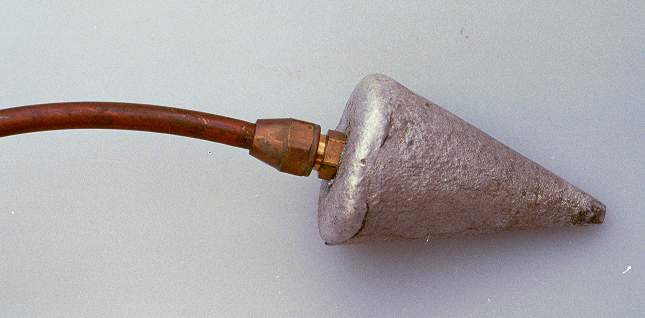
- An aluminum cone drilled to fit on a straight or bent
blow tube, used to shape and open bubbles of glass.
Steinert $50; Moore $30, 45; Homemade cast from aluminum
cans with copper pipe $10. May be used with breath or low
pressure air. This is my second cast puffer head, much
smoother than the first. Commercial heads are hollow behind. Aluminum is tapped for 1/4"
water pipe (about 1/2" OD) and the fitting shown
allows the copper tubing for blowing. A reducing fitting
1/4" to 1/8" allows screwing it onto a standard
air valve for a shop blower. Later a quick connect fitting was
screwed in with hose slipped over that as more convenient. 2003-10-23
Sofietta
- Punty
- Most often a solid tipped rod, with hollow or solid
shaft, to take glass piece from the pipe so the lip can be worked
but also used directly for paperweights and sculpture. Also used for gathering glass for
hot bits of various shapes. Usually 54" long like
pipes, 1/2" tip most common. Homemade from surplus
solid rod $5-8. Product Ref. Solid: A.R.T.Co. $26. Hollow:
$65 May also have a special shape
grip or container on the end for production work. Sabot, Snap - also links to punty page.
- Q
A B C D E F G H I J K L M N O P Q R S T U V W X Y Z
- R
- Reciprolap
- A machine for semi-automatically grinding the bottom of paperweight,
vases, etc. Requires preliminary flattening and a rubber ring around
each piece. The lap consists of a plate that rotates or vibrates and
has an abrasive plate or pad or cerium oxide on a soft pad. Consensus
is that Jack Rose industrial machines are the best choice. Lots of
argument about diamond vs. various grits vs. pads. 2003-07-20
- Refractory
- Any material that withstands the high heat needed for
melting glass, the two most common being clay and ceramic
fiber substances. Special clays fire up to form bricks
that do not deform in the heat. If previously fired clay
(grog) and organic material is added to the mix,
insulating firebrick is created by the empty spaces in
the fired clay. Ceramic fiber is a result of space
research and insulates well. Two other refractories,
known to gardeners, and sometimes used as insulation are
vermiculite, which is expanded mica from volcanic regions
and Perlite, which is made by heating crushed natural siliceous rock so
the combined water makes it pop like popcorn.
http://www.perlite.net
refracto.htm
- Regulator
- A device for controlling pressure, most often gas pressure in the glass
studio. Gases used are stored or delivered at pressures too high for
use, so a mechanical regulator uses springs to balance the pressure and
control valves to supply useable pressures. May require two devices in
series for very high pressure gases (oxygen, 2000
psi) used at low pressure (10-20 psi) 2009-07-26
- Relay
- Device for controlling power in one circuit with another
circuit. Controllers and
Controlling Electric Power
- Ribbon Burner
- A ribbon burner in furnace work is a block of refractory
with a couple of dozen holes set in the side of a glory
hole. It is quieter (lower velocity flame) and more even
heat - uniform from front to back. Most furnaces use a
blast burner with the air and gas entering at fairly high
velocity, which can be noisy. Many glory holes are heated
the same way and some people like the torch effect. See Burner (There is also a ribbon burner
in lampworking for heating a length of tubing for a long
bend made of a pipe with holes in the side.) For a
picture see Henry
Halem's page
- Rollers
- Many shops have a set of rollers somewhere. Sometimes
these are mounted on the bench arms,
sometimes on a stand or on a flat plate. When on the arms
or on a stand, the most common use is to simply work the
glass in place, turning the glass in place instead of
rolling along the bench arms. This may be gaffers choice,
as a convenience to the person supplying air, or for use
of an automatic air supply. When on a flat plate, the
common use is threading. See also yoke
- S
- Sabot
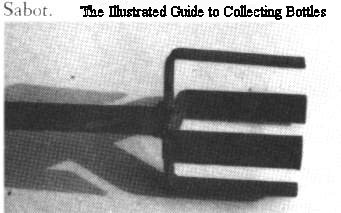
- Apparently a cup shape made with prongs, probably covered
with soft refractory, used to hold base of bottle for
final working. Shown in IGCB
gripper.htm
- Sand Blaster
- See cold working abrasive blaster COLD WORK.HTM
- Scoop, Batch or Cullet
- See Trough
- Scoop, Molten Glass
- At the end a blowing session, if the furnace is to be
shut down, the last of the glass must be removed to the
bottom of the pot to keep the glass from freezing in the
pot. The real problem is not on cooling, but on
reheating, when the glass commonly
 expands more quickly
than the pot, before getting molten, and cracks the pot.
A scoop allows removing glass quickly. It is normally
dipped in water to chill it before going into the furnace
and allowed to drip off into a bucket of water or be
plunged into the bucket. This one is rusty from being
outside, unused, for a while; I normally reheat the end
and dip it in motor oil to carbon treat the end. It was made by welding
the domes sold for capping off steel pipe to 12" square tubing. MF expands more quickly
than the pot, before getting molten, and cracks the pot.
A scoop allows removing glass quickly. It is normally
dipped in water to chill it before going into the furnace
and allowed to drip off into a bucket of water or be
plunged into the bucket. This one is rusty from being
outside, unused, for a while; I normally reheat the end
and dip it in motor oil to carbon treat the end. It was made by welding
the domes sold for capping off steel pipe to 12" square tubing. MF
- Scoop, Color Powder
- One method of holding color powder for rolling molten
glass in it. Take a couple of aluminum ice scoops and set
them in plaster or concrete so they can be lifted out to
return the powder to the container. Powder Cup
- Shaft Collar
- A thick (3/8"-1/2") washer with a set screw in
the side that allows locking it on a pipe or rod. Most
commonly used in glass for hanging the pipes and punties
for cooling the glass. Made originally to keep a shaft
from moving through a bearing, so sold with bearings.
Come in hard steel and softer (zinc?) versions, the
latter needed if drilling out is needed as it is for
water pipe which is not exactly 1/2" or 3/4" OD.
- Shears
- Mostly like tin snips (but see Diamond
Shears), available with various shaped cutting edges
- straight, duckbill, etc. - used
for trimming the lip and otherwise cutting away glass.
Putsch $32, Steinert $85, Moore $50 Littleton
states that tin snips have a blunt shearing edge, which
chills the glass too much; glass shears must have a sharp
thin edge. OLY
- Shield
Protection from heat.
| Most glass workers who do not use long sleeved shirts
pull a cotton sock with the toe end open over their arm when working
bigger pieces. Kevlar sleeves are now available. Wooden paddles held by
other workers and full fledged flame gear are also used. Many workers
put some kind of upright shield at the glory hole for body protection
and to control ventilation and may shield yokes and hand tools. (the
shield at far right has a window, a marver shelf and hangers for the
rods to open the door.) Most benches have a metal panel under the right
arm to shield the gaffer's leg. A plastic shield may be used for
physical and optical eye protection. OLY At two
studios in Seattle a large shield the shape of a ping-pong paddle (right) with a
slot opposite the handle blocks the heat from a large gloryhole when wide
open, the slot going over the punty/pipe. 2003-06 Both the standing
shields at right have shelves for resting tools. The one in the
center also has a shaded insert viewing shield. The one in the
center is cut away at the bottom to overlap the track. 2004-09 |
|
|
- Snap
 Snapcase
Snapcase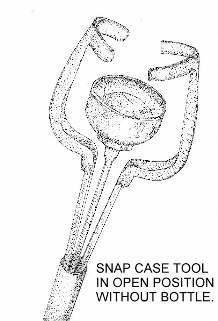
- A kind of punty for working the neck
on bottles, with a cup to take the base of the bottle and
arms with curved grip ends to hold the neck - shown
without padding in IGCB
gripper.htm
This very good site
http://www.blm.gov/historic_bottles/glassmaking.htm#Empontilling from
the Bureau of Land Management has an image of a snap which holds the sides
of the bottle.
- Sofietta
- Italian name for puffer
GL5K 2005-11-28
- Steam Pad
- If soggy newspaper is dropped on the floor and a puntied piece is
lowered so the rim touches the paper, the steam formed will inflate the
piece, forming it. Seen at GAS Conf 2003 Demo. 2003-06-20
- Steam Stick
-
Glass may be "blown" without using breath or
even a pipe, by using wet wood to both block an opening
and produce steam inside the opening to inflate the piece.
Such a piece of wood is a steam stick.
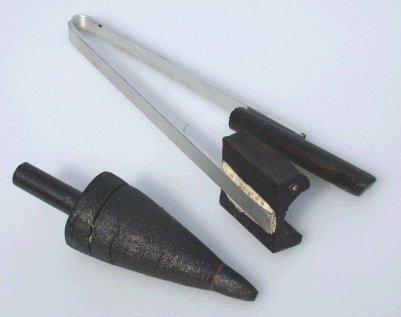 The steam stick must be rotated
with the glass to keep the seal, therefore a cone shaped wood with a smaller
handle is useful. [right] A ricer or mortar pestle is formed right if
one small
enough can be found. I could not, so I made
one. 2003-06-20 MF it seems likely
that a deep hole should first be made with a metal rod,
unlike my attempts to make the hole with the wood. [confirmed on the
net]
Commercial model 2004-05-01 The steam stick must be rotated
with the glass to keep the seal, therefore a cone shaped wood with a smaller
handle is useful. [right] A ricer or mortar pestle is formed right if
one small
enough can be found. I could not, so I made
one. 2003-06-20 MF it seems likely
that a deep hole should first be made with a metal rod,
unlike my attempts to make the hole with the wood. [confirmed on the
net]
Commercial model 2004-05-01
- Support
- When wrapping glass, as well as other times, a simple
support is needed to keep a punty steady, so a couple of
T supports are handy to have around. Homemade $10 If ball
bearings are added, easier to turn, like a yoke.
- T
Tagliol
-
 Flat
metal blade with heavy handle, used for flattening and grooving into hot
glass. 2003-10-25 Examples by Jim Moore Flat
metal blade with heavy handle, used for flattening and grooving into hot
glass. 2003-10-25 Examples by Jim Moore
- Tank Furnace
- A furnace for melting glass, usually starting about 300#
and going up. A tank is usually rectangular and is lined
with hard high temp fire brick which is sealed when the
glass flows into the cracks and chills. A continuous tank
has a barrier and two burner areas; raw glass is melted
on one side of the barrier and flows under the barrier
for pickup, leaving surface crud behind. See Pot furnace. Furnaces
- Tank, Gas
- Commonly, a metal container built to withstand pressure to hold gas at
room temperature. Depending on the storage pressure of the gas may be rather
thin walled (propane, 250 psi) or very thick
walled and heavy (acetylene,
oxygen, 2000 psi). Usually noticeable by
domed/hemispherical ends to withstand pressure. Supplied with valves
and fittings to attach pressure regulator and plumbing; these are shaped
differently for each kind of gas for safety. 2009-07-26
- Thermocouple
- A device for measuring temperature using an effect where
a voltage is created in a material when the temperature
varies along its length. Thermocouples are usually two
kinds of metal wire. The effect is also used in one form
of flame sensor. Different metals
make different kinds of thermocouples, by far the most
common in glasswork being Type K and N because in large
diameter wire (16 gauge or more) the temperature range
extends up to 2300°F where most glass is thoroughly
melted. Type S and R thermocouples use platinum alloys and are
more accurate and accurate longer, but costs much more, $200-250.
Another platinum measuring device, an RTD (Resistive
Temperature Device) uses a Platinum resistance coil but can not get as
hot. Most mini-controllers
will work with a couple of platinum RTD's and several
types of thermocouples. More
on thermocouples
- Threading Rollers
- Four bearings mounted on two brackets on a flat plate to
allow quickly spinning the pipe/punty and the glass on it
to run a thread of color around/along the glass. Brackets
can be twisted before bolting down to spiral thread
around the piece. Homemade with bicycle axles or
bearings, $20, Steinert $95 Threading
- Torch
-
 Most glass studios have one or more hand held torches. At
the low end are propane
braising torches. Some studios use an oxy-gas or
acetylene torch (much hotter) for melting
work and have spaces piped for gas. The top of the line torch (which can
cost over to $200) is a high Btu flame
thrower that is used for heating parts of the pieces (especially
the punty gather) during a long working session. There is a
picture of Josh Simpson using an oxy-acetylene heater
head on one of his huge glass worlds. TORCHES.HTM Most glass studios have one or more hand held torches. At
the low end are propane
braising torches. Some studios use an oxy-gas or
acetylene torch (much hotter) for melting
work and have spaces piped for gas. The top of the line torch (which can
cost over to $200) is a high Btu flame
thrower that is used for heating parts of the pieces (especially
the punty gather) during a long working session. There is a
picture of Josh Simpson using an oxy-acetylene heater
head on one of his huge glass worlds. TORCHES.HTM
Lampworkers and neon tube benders use a variety of bench
mounted torches, some with several heads, the most
accepted of which have fine controls and runs off propane
and oxygen. When a furnace worker has one, it is usually
used to make the bits that end up in paperweights or
paperweight style blown pieces. (More
info at Arrow Springs)
- Trough, Batch or Cullet
- When loading batch or cullet into a furnace, often the
opening is not so large as a shovel, and batch should not
be spilled around the shop. Also, getting into the heat
with a shovel may be awkward. One solution is to bend up
a long trough or scoop from sheet metal, 2-3 feet long
and 4-8" wide into which the material is placed well
back from the furnace, the end being then placed through
the door and the whole dumped into the center of the pot.
Wear a respirator when working with batch and good gloves as the metal gets hot quickly if
the furnace is at heat.
- Tweezers
- Tweezers
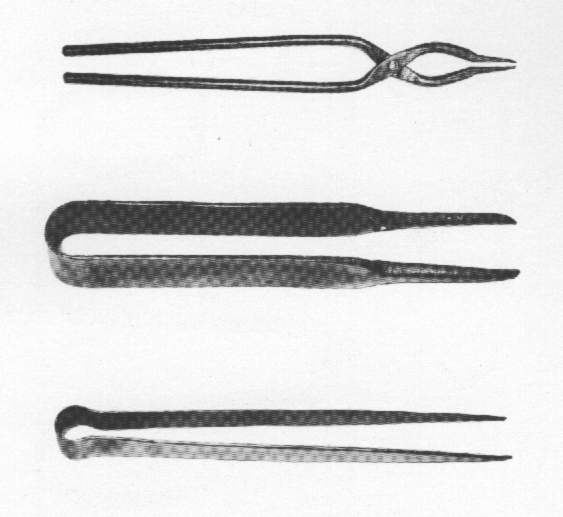 made for glass working are long and
wide spread and have bent in tips for fine gripping. They
can be used as fine jacks when needed. Many hardware
stores have oversized stainless steel tweezers
that can be spread from their normal width and yield to
grinding and bending the tips. Commercial glass tweezers have an
inside curve so when closed more water can be held between the tips for
chilling the jack line. 2003-07 made for glass working are long and
wide spread and have bent in tips for fine gripping. They
can be used as fine jacks when needed. Many hardware
stores have oversized stainless steel tweezers
that can be spread from their normal width and yield to
grinding and bending the tips. Commercial glass tweezers have an
inside curve so when closed more water can be held between the tips for
chilling the jack line. 2003-07
- Type K, Type N, Type R, Type S
- Designations for kinds of thermocouples used for
measuring high temperatures. 2006-05-06
- U
- V
V-Block
- A V-block is two pieces of wood nailed edge on with a triangular fill
piece at one end. Wet newspaper is placed in it as
liner and partially blown glass is placed on the wet glass in line with the
length of the V to form cylinders. Like having 6-8 hands doing newspaper
blocking.
CraftWeb 2007-11-24
- Vacuum Plate Vacuum Encasement, Stump Sucker.
- "Attention paperweight makers! This vacuum plate
will assist you in drawing glass over your figures and
help to eliminate bubbles. The unit comes in four parts:
the cylinder, cup, vacuum plate and stand. The vacuum
plate and cylinder can be made to your weight/size
requirements. SIWS - Vacuum Plate Assembly (includes 1
cylinder) $700 - Vacuum Plate Cylinder (2, 2.25, 2.5, 3,
3.5, or 4 inch) $150"
Vacuum Plate The unit pulls clear glass down around the prepared
inclusion, which should be near annealing temperature. Ideally, the
vacuum pump should be connected to a buffer tank to allow for a quick heavy
suck. 2005-04-04 mod.
- W
- Water
- Water is a tool in a number of ways in the glass shop,
most directly when it is used to chill glass causing a
crackle effect.
- Wood
- Fruit woods of various kinds, most often cherry, but
apple, pear, etc. are used in a number of ways in furnace
glassblowing. All wood that touches the glass is soaked
in water until it is water logged (sinks); once it is
soaked, it must usually be kept wet or it will split on
drying. Fruit wood is used because to has a tight even
grain that holds water nicely and burns to a smooth
carbon surface, besides smelling good when smoking. Blocks are chunks of wood, with or
without a handle, with a spherical hole in them, for
shaping and cooling the outside of the glass. Paddles are flat pieces used for shaping
bottoms and squashing cookies and other items flat.
Dowels or rods are used inside the opening for shaping.
Blocks and chunks of wood to make blocks are the hardest
to get. Thin flat boards and dowels in cherry can be
gotten from hardwood supply companies and woodworking 800
number companies. For example, Woodworker's Supply 1-800-654-9292
(505-821-0574) offers 36" cherry dowels in 11 sizes
from 1/4" to 1 3/4" with prices of two common
sizes being 3/4" (203-011) $3.40 and 1" (20301)
$4.65 and Paxton Woodcrafters Supply (formerly Paxton
Beautiful Woods) in Grand Prairie, Texas stocks flat
boards with a finished thickness of 0.25, 0.625. 0.78125,
1.0625, & 1.75"
- X
- Y
- Yoke
-
An arrangement of bearing balls, often
on a Y frame, to support the pipe/punty at the fire and
allow continued turning while heating, supporting the
hotter, heavier end. At right, Yoke under end of pipe.
From Putsch $118.50, $70; Steinert $90; (all require
adding a base and rod.) A heavy duty yoke like Dale might
use, has a bearing at the joint of the upper and the
shaft to allow swiveling the load of glass around, and
wheels at the base, on a track for support when pulling
out. Buying transfer
balls used for materials handling from a woodworking
catalog and bolting/welding a brace and base, about $20.
Woodworker's Supply index under "Rollers": 853-756
5/8" Transfer ball, $2.75 each, 853-763 1"
Transfer ball $2.95 each. I got the former. These are
flange mount; stud mount is easier to fit. I put a steel
shield on my yoke so that the balls rest in a Vee in the top accepts the
rod and the shield protects the hand, somewhat. Bricks provide weight in
base. A bed frame clamp provides adjustability.
The yoke at the far right is fairly common in Seattle. The tracks are
angle iron with the V pointing up with welded flat straps between them.
It can be slid around on the floor or stored out of the way. The
platform has rollers so it can be rolled in and out. Height is
adjusted with a handle screw about halfway up. The near edge of
the lower platform is raised so the unit can be pushed with the foot.
Another base form is an H with a rebar welded across the near side for
the foot. 2004-09-09
See special handling references at Gimmick |
 |
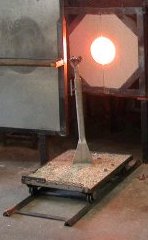 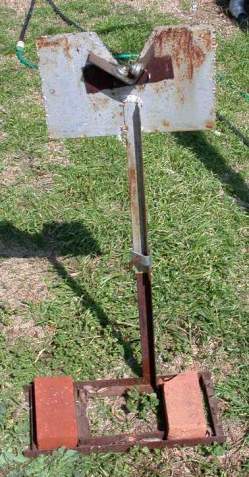 |
- Z
A B C D E F G H I J K L M N O P Q R S T U V W X Y Z
Sources have been moved to Sources
for better maintenance.
- Sources of terminology (uncredited
are from general experience)
- GGNJ
- The Glass Gaffers of New Jersey, Adeline Pepper, Charles
Scribner's Sons, NY, 1971, ISBN 684-10459-8
BIBLIO.HTM#GGNJ
- GGW
- Glass and Glassware, George Savage, Octopus Books,
London, Dist in US Crescent,div.of Crown 1973, ISBN: 0-7064-0143-3
BIBLIO.HTM#GGW
- SEARCH
- Glassblowing, A Search for Form, Harvey K. Littleton,
1971 ISBN 0-442-24341-3 (paperback 1980) Exploration of
the beginnings of Studio Movement glassblowing. littletn.htm
- SIWS
- Steinert Industries Web Site (see above)
-
Glass working terms not tools, equipment, or bits
- Gaffer
- from old term for grandfather, the person with the most
experience working glass who does the most critical steps
of the working and coordinates the rest of the team.
Title given to the person in charge of a piece even if
others have more experiences. Other people have titles
like bit boy, bit gatherers, footers, handle makers,
reheat boys, etc.
- Gather
- Both the name for going to the furnace to get glass (to
gather, gathering) and for the glass gotten (first
gather, second gather). The end of the pipe or punty is
lowered into the glass and turned to drag the glass
evenly around the pipe or previous gather. The analogy
most often used for the process is turning a spoon or old
fashioned wooden pickup in honey, keeping it turning to
get to the plate. However, gathering glass involves stuff
that is over 2000°F that will melt and deform the
previous gather if done too slowly (not to mention set
clothes smoking.)
- Moile
- the name for the blob of glass at the end of the pipe
before it has enough done to it to call it the bowl or
stem or body or something else.
Glossary Table of Contents
This page printed from Mike Firth's Hot Glass
Bits recipes. All rights reserved
|
 Snapcase
Snapcase
 The steam stick must be rotated
with the glass to keep the seal, therefore a cone shaped wood with a smaller
handle is useful. [right] A ricer or mortar pestle is formed right if
one small
enough can be found. I could not, so I made
one. 2003-06-20 MF it seems likely
that a deep hole should first be made with a metal rod,
unlike my attempts to make the hole with the wood. [confirmed on the
net]
Commercial model 2004-05-01
The steam stick must be rotated
with the glass to keep the seal, therefore a cone shaped wood with a smaller
handle is useful. [right] A ricer or mortar pestle is formed right if
one small
enough can be found. I could not, so I made
one. 2003-06-20 MF it seems likely
that a deep hole should first be made with a metal rod,
unlike my attempts to make the hole with the wood. [confirmed on the
net]
Commercial model 2004-05-01 Flat
metal blade with heavy handle, used for flattening and grooving into hot
glass. 2003-10-25 Examples by Jim Moore
Flat
metal blade with heavy handle, used for flattening and grooving into hot
glass. 2003-10-25 Examples by Jim Moore Most glass studios have one or more hand held torches. At
the low end are propane
braising torches. Some studios use an oxy-gas or
acetylene torch (much hotter) for melting
work and have spaces piped for gas. The top of the line torch (which can
cost over to $200) is a high Btu flame
thrower that is used for heating parts of the pieces (especially
the punty gather) during a long working session. There is a
picture of Josh Simpson using an oxy-acetylene heater
head on one of his huge glass worlds. TORCHES.HTM
Most glass studios have one or more hand held torches. At
the low end are propane
braising torches. Some studios use an oxy-gas or
acetylene torch (much hotter) for melting
work and have spaces piped for gas. The top of the line torch (which can
cost over to $200) is a high Btu flame
thrower that is used for heating parts of the pieces (especially
the punty gather) during a long working session. There is a
picture of Josh Simpson using an oxy-acetylene heater
head on one of his huge glass worlds. TORCHES.HTM  made for glass working are long and
wide spread and have bent in tips for fine gripping. They
can be used as fine jacks when needed. Many hardware
stores have oversized stainless steel tweezers
that can be spread from their normal width and yield to
grinding and bending the tips. Commercial glass tweezers have an
inside curve so when closed more water can be held between the tips for
chilling the jack line. 2003-07
made for glass working are long and
wide spread and have bent in tips for fine gripping. They
can be used as fine jacks when needed. Many hardware
stores have oversized stainless steel tweezers
that can be spread from their normal width and yield to
grinding and bending the tips. Commercial glass tweezers have an
inside curve so when closed more water can be held between the tips for
chilling the jack line. 2003-07 










 Special pliers with a sharp diamond shaped opening for
cutting Hot Glass Bits and, usually, a round
opening at the tip for controlling punties, pulling
glass, etc. Shown at second from left at right. From Steinert $90. See also
Special pliers with a sharp diamond shaped opening for
cutting Hot Glass Bits and, usually, a round
opening at the tip for controlling punties, pulling
glass, etc. Shown at second from left at right. From Steinert $90. See also 
 Tool
for shaping the thin flat foot of a goblet. Most commonly
a pair of thin (1/4") fruit wood (cherry) boards
about 3" by 4" (75mm x 100mm) hinged on one
long edge with a slight semicircular dish sanded/cut into
the face of one board along the opposite edge from the
hinge with a notch cut for the stem. The wet tool is
gripped in the palm of the hand and brought up to the hot
glass foot gather and the boards closed around the glass.
The dish forms the upper side of the foot, the flat board
opposite the bottom of the foot. Footer at right, with
three different sized cutouts, from Harvey Littleton's
book. Also made with handles and with graphite pads,
costing about $250
Tool
for shaping the thin flat foot of a goblet. Most commonly
a pair of thin (1/4") fruit wood (cherry) boards
about 3" by 4" (75mm x 100mm) hinged on one
long edge with a slight semicircular dish sanded/cut into
the face of one board along the opposite edge from the
hinge with a notch cut for the stem. The wet tool is
gripped in the palm of the hand and brought up to the hot
glass foot gather and the boards closed around the glass.
The dish forms the upper side of the foot, the flat board
opposite the bottom of the foot. Footer at right, with
three different sized cutouts, from Harvey Littleton's
book. Also made with handles and with graphite pads,
costing about $250 

 A
hairpin shaped tool that springs open and when closed has
long blades that are parallel about 12-15" long used
for shaping glass. All parts of the tool are used by
skilled glass workers, but the blades get the most use:
closing in the narrow neck of the piece on the pipe and
working the opening of lips. Blades may be nearly knife
edged or rounded. Jacks are also made to hold round (replaceable)
paper or wood "blades" -
A
hairpin shaped tool that springs open and when closed has
long blades that are parallel about 12-15" long used
for shaping glass. All parts of the tool are used by
skilled glass workers, but the blades get the most use:
closing in the narrow neck of the piece on the pipe and
working the opening of lips. Blades may be nearly knife
edged or rounded. Jacks are also made to hold round (replaceable)
paper or wood "blades" - 
 Metal,
marble or graphite plate, most often steel, used for
rolling glass to a cylinder or cone and chilling the
surface to firm it for blowing. Should be large enough to
roll largest piece over a more than one turn (over 2' for
8" piece) Some marvers are mounted at an angle or
are adjustable to an angle which makes for easier work
when many pieces are to be made with a tapered shape. A
marver may have textured surface (see also
Metal,
marble or graphite plate, most often steel, used for
rolling glass to a cylinder or cone and chilling the
surface to firm it for blowing. Should be large enough to
roll largest piece over a more than one turn (over 2' for
8" piece) Some marvers are mounted at an angle or
are adjustable to an angle which makes for easier work
when many pieces are to be made with a tapered shape. A
marver may have textured surface (see also 

 A method of quickly applying water to a pipe which has
gotten too hot to handle often from gathering low glass in a furnace. Can range from a wet rag to a
dedicated spray tube with a foot switch, but the most
common pipe cooler seems to be V shaped box with holes in
the bottom, notches on the bottom of the ends to fit the
pipe, and a handle across the top. It is sunk in a barrel
of water to fill, removed, the pipe laid across the
barrel, the cooler placed and moved back and forth on the
pipe until the water drains out. Wet rags or tubing with
pumped water can also serve. Homemade
A method of quickly applying water to a pipe which has
gotten too hot to handle often from gathering low glass in a furnace. Can range from a wet rag to a
dedicated spray tube with a foot switch, but the most
common pipe cooler seems to be V shaped box with holes in
the bottom, notches on the bottom of the ends to fit the
pipe, and a handle across the top. It is sunk in a barrel
of water to fill, removed, the pipe laid across the
barrel, the cooler placed and moved back and forth on the
pipe until the water drains out. Wet rags or tubing with
pumped water can also serve. Homemade 


